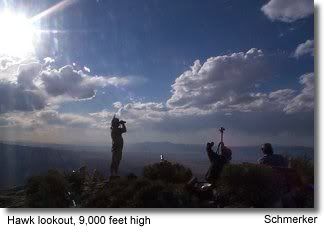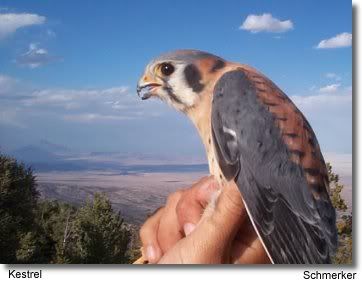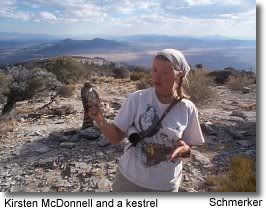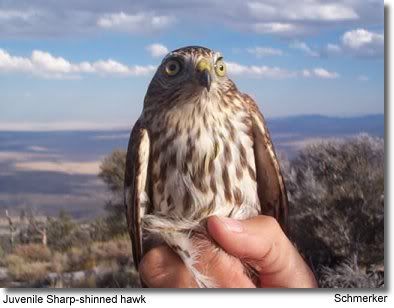There are a handful of associations with Cooper, but Laura's main one was that on our second date she tagged along with me while I reported a story for Utah.com and the Tooele Transcript-Bulletin on the Hawkwatch International raptor count, atop Goshute Mountain in the remote Toana range. Near the end of our weekend with the biologists and bird counters, someone snared a Cooper hawk, banded it, and handed it to Laura who held it in her open palm for a moment before the bird realized the trick and resumed, in an instant, it's flight to South America.
I had a photo of Laura holding the bird before it fled, but that does not survive digitally--only in a now-yellowed paper copy of the Transcript-Bulletin. Here, however, is the Utah.com story, reprinted, which tells that story ...
Raptor counting with Hawkwatch
Pressing both eyes into his binoculars to peer at a flying object so far away it is not visible to the naked eye, Jerry Liguori calls out: 'Kestrel, over the Pequops, adult male.'
Looking another second at the hawk, he drops the binoculars and punches a multi-buttoned tabulator on a makeshift table here on Goshute Mountain, 9,000 feet high. Probably about a minute later I see what may be that kestrel as it zooms by, but by that point Liguori has picked up his binoculars and spotted a half-dozen more birds headed south. Shielding his eyes with a floppy broad-brimmed hat and draping red bandanna, he scans the sky and horizon northeast again. There are kestrels, males and females of unidentifiable age, sharp-shinned hawks over ridges to the north, a rare turkey vulture and Cooper's hawks and Swainson's hawks. In all, on this cloudless Saturday, over 1,600 raptors will be counted.

This is the 21st year Salt Lake City-based HawkWatch International has stationed volunteers, college students and raptor experts atop Goshute Mountain to count birds during the seasonal southward migration. That length of time makes the site, which sits about 25 miles due south of Wendover along the Utah-Nevada border, one of the best in North America for gauging the health of raptor populations.
The counting season, which typically lasts from mid-August until late-October, involves not just sharp eyes, good bird identification skills and altitude-adjusted lungs but also the sort of detailed logistics sufficient support a dozen or so counters - most of them in their 20s and 30s and almost all of them holding at least one college degree - on top of a mountain for a full season, through blinding sun, shivering cold and driving rain and snow.

But more than that, perhaps, it offers a chance to see a bunch of wildly beautiful birds up very close, and a glimpse into the rarefied world that raptors inhabit.
The reason for the count, said HawkWatch executive director Howard Gross as we stand atop the windswept mountain, is to gauge the health not just of bird populations but also of the environment in general. Raptors prey on a variety of animals, fly from one country to another, and are easily affected by pollutants or habitat degradation. Therefore, counts such as the one on Goshute Mountain offer a snapshot of the health of the roughly 17 species who fly by each fall.
Goshute Mountain is a focal point for counting due to its unique geographical setting. Northwest winds push the birds gradually east as they make their way south. But past the Goshutes lie the Bonneville Salt Flats - a dry area birds want to avoid. Trying to keep along the ridge tops and being pushed by upslope winds, almost all hawks end up flying over the peak, most at 20, 30 or even 40 miles per hour. They appear as a dot in binoculars for a few minutes, then come sailing by, some just feet above the observers. Wildlife observers call this the Intermountain flyway.

My friend Laura Patterson and I stand looking north, watching the hawks descend toward and past the peak like shooting stars. But as much as we look out for the hawks we also spend a lot of time just looking. I don't know how many of you have ever stood on top of a mountain but I have stood atop a bundle yet don't think I will ever entirely get used to it. From the peak, one mile down the valley curves away at weird fish-eye lens angles, lonely dirt roads cross playas and cow trails lead to water tanks. To the east, the salt flats shimmer, Deseret Peak near Grantsville sparkles along the horizon, and Interstate 80 is but a thin line on the desert. South, high peaks like Moriah, Schell and Wheeler poke skyward. Westward, the Ruby (one great mountain range, should you ever make it to Nevada), Independence, Peqoup and Humboldt mountains fade into the horizon. To the north, Pilot Peak is the beginning of hundreds of peaks that lead to Idaho. On this particular Saturday afternoon a patchwork of cloud and shadow blanket the surrounding 100,000 square miles - most of it devoid of humans - and virga cut across the sky.
Identifying the birds is much more complicated than seeing what color they are and then comparing that image to a picture in an identification book. Since the hawks are often so far away and backlighted against sky, clouds or mountainside they usually appear in relief, devoid of color. Identification then comes down to factors like stability in flight and proportional differences in head size, wing angle and tail length and width. Making an identification under these conditions take years of experience, said Gross, 'and a mind like a flow chart.' Liguori, who is from New Jersey, apparently has one of those mind. He once spent over 1,000 hours counting hawks from a site at Cape May, N. J., counting every day from August 15 to November 30 - save one, when he went to his brother's wedding. 'It killed me,' he said of the day off. 'I felt like I was missing something.'

Though Goshute Mountain, which straddles the Utah-Nevada border, is perhaps the most important raptor counting site in America, there are a handful of other sites producing significant and important wells of data. But it was the site on Hawk Mountain in Pennsylvania that started it all. Hawk counts there have been ongoing since the 1930s, and it is that data that Rachel Carlson tapped to show that the pesticide DDT was killing huge numbers of birds. Carlson wrote 'Silent Spring,' the book many think was responsible for the modern environmental movement.
Just downslope from Goshute Mountain's observation area, a group of about six men and women trap hawks and take detailed measurements of the trapped hawks. At a trapping area observers use a dove, pigeon and sparrow to attract passer-by hawks. The lure birds are in a harness attached to a tall pole, and when a hawk is spotted the lure birds are yanked into the air to mimic injured birds. If the observers are successful, the hawks will dive on the injured but get caught in netting traps. After an hour, the lure birds are given a break and freshies take their place. Once caught, observers like Debbie Sandack measure tail length, leg length, talon length, wing fat and determine if there is food in the bird's stomach. One Sharp-shinned hawk she held was amazingly patient, like a dog being assaulted by adoring children. Sandack held the bird as though it were an ice cream cone and the hawk, mouth open and eyes ablaze, looked back at her. Prodding finished, she tossed the bird, and it took off. From trapping to release, the entire procedure took just 15 minutes.
'This sparks a flame for people,' HawkWatch executive director Howard Gross said both of the birds and their restoration programs. 'We are often the first environmental group a lot of people join, and one of the things we try to do is expose people to lots of ecological principals and the effects humans can have on the food chain or their own environment. Oftentimes what we can do is get someone to adopt a power line, and have them go out and identify electrocuted raptors. When people start doing that, believe me, pretty soon the power company is out there putting up raptor detractors to keep the birds away. All of the sudden this person has power and has taken responsibility for what is going on, and then they can say, I feel that I have saved that raptor's life. This way we can work with these people and make them understand how they can have a positive impact on their environment.'
Pulse of the Planet

Sharp-Shinned HawkGross told the story of a HawkWatch observer who followed the Swainson's hawk migration to the southern pampas of Argentina. There, the observer saw tens of thousands hawks who apparently died after eating grasshoppers. The grasshoppers had been sprayed with a heavy-duty pesticide that killed the birds after consuming only a few of the bugs; the chemical had been applied by a farmer who wanted to kill the grasshoppers but who gave no thought to the birds who might eat them. Now, conservation groups have begun to work with farmers and government agents to protect wintering birds from previously unforeseen threats. Similarly, last winter Gross was bird watching in Costa Rica and while watching a black-necked stilt he realized the bird probably spends summer in the marshes around Great Salt Lake. He turned to his local guide and told him that the bird 'comes from my home, and at my home I do what I can to protect it. I hope you would do the same. His forehead wrinkled, but then you could tell that he got it.
'To me, the bird migration is really the pulse of the plant,' Gross continued. 'It is a measure to see the health of the planet, and it really is something you can measure.'
Back at the raptor measurement station, Sandack, who trades her position with other observers every hour or so, works out of one of about a half-dozen tents set up on the mountain. Over the summer the Bureau of Land Management brought up 20 helicopter loads of supplies, each load weighing 500 pounds, including about 1,200 gallons of water to last the summer. The dozen or so 'volunteers' - two counters, two educators, one project coordinator, one cook and six trappers - live on top of the mountain in what roughly resembles the backpackers' handmade village in that movie 'The Beach.' Several dozen tents are scattered about in a medium-density camper's village just off the top of Goshute Mountain, snuggled into a beautiful forest of spruce, single-leaf ash and vibrant bristlecone pines. There is a common mess tent, a composting toilet, a gathering area with chairs and assorted outbuildings and shelters that house supplies, observation blinds, measurement stations, and the lure bird aviary.

Most volunteers - they are paid per diem - stay for the entire migration season, taking one day off a week when they usually head down to Wendover to shop, do laundry and play the nickel slots in the casinos. (A Wendover casino owner gives observers free rooms while they are in town.) The hike from the trailhead back up the mountain covers 1,800 vertical feet and takes at least two hours.
'I've been here a month but I can hardly imagine what it is like to not be up here,' Helena Kokes, one of the educators, said one night as everyone sat on the 'back porch' - a slab of rock at the edge of the mountain - watching a fat red moon rise over Deseret Peak. To the north, lightning rang over the salt flats. I had only been there about six hours at that point, but I already could envision what she meant. Up on the mountain, watching the world turn from a solitary spot, civilization and cities seems very, very far away. Late at night, a single pair of headlights is visible for a half-hour as it winds through the hills far below and toward Wendover. A satellite flips through the air overhead. The volunteers read for a while, talk, maybe smoke a cigar, and call it a night. This is the world.
The next morning, within a half-hour of sunrise, Liguori is back at work on the peak. Hawks are soaring south. 'They are coming already,' he says against the cold morning wind. 'I had hoped to ease into it.' Later, he adds: 'This is not just bird watching. This is hard work.'

Most observers, when asked why they do it, cite the importance of data gathering for species and environmental health. But another certain draw is the simple beauty of the birds themselves and the metaphoric mystery of their lives. Most hawks weigh a pound or less yet commute every spring and fall from one end of the planet to the other - it is 9,000 miles from Alaska to Argentina. Kirsten McDonnell, one of the educators on the mountain, gently handed me a hawk the first afternoon I was there. She gave another to Laura, a transplanted Georgian with a sweet Southern accent who now lives in Salt Lake City. The bird wriggled some, but mostly kept still and stared back at me with clear, unblinking eyes. Its feathers were precisely patterned, its body honed by millennia of evolution.
On Sunday afternoon, as Laura and I were getting ready to troop down the mountain, someone brought out a small battery-powered transistor radio, and tuned it to Salt Lake's community radio station, KRCL, the best station in the world.* (* The second best, incidentally, is Radio One out of Dar Es Salaam, Tanzania.) 'It seems like we get every radio station in the world out here,' McDonnell said. Later, she handed me a Cooper's hawk. The hawk had been wrapped in her hand but she placed it slowly and gently into my palm. The bird, thinking it is still trapped, rests there, its heart beating madly. It looks forward then sideways, and in a seeming nanosecond it takes off on its unimaginable journey south.
On the radio, a folk guitarist sings:
We got things so good
it seems hard to believe
we live on the outskirts of town